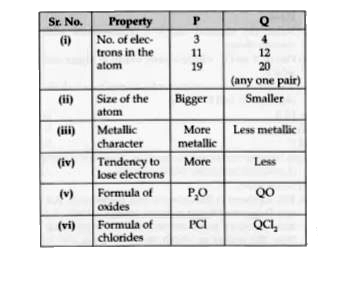Two elements 'P' and 'Q' belong to the same period of the modern periodic table and are in Group -1 and Group -2 respectively. Compare their following characteristics in tabular form:
(i) The number of electrons in their atoms
(ii) The sizes of their atoms
(iii) Their metallic characters
(iv) Their tendencies to lose electrons
(v) The formula of their oxides
(vi) The formula of their chloridesSolution in Kannada
Topper's Solved these Questions
- PERIODIC CLASSIFICATION OF ELEMENTSBOOK - OSWAAL PUBLICATIONCHAPTER - PERIODIC CLASSIFICATION OF ELEMENTSEXERCISE - TOPIC:2- LONG ANSWER TYPE QUESTIONS
5 Videos
- PERIODIC CLASSIFICATION OF ELEMENTSBOOK - OSWAAL PUBLICATIONCHAPTER - PERIODIC CLASSIFICATION OF ELEMENTSEXERCISE - NCERT CORNER -INTEXT QUESTIONS
13 Videos
- PERIODIC CLASSIFICATION OF ELEMENTSBOOK - OSWAAL PUBLICATIONCHAPTER - PERIODIC CLASSIFICATION OF ELEMENTSEXERCISE - TOPIC:2-SHORT ANSWER TYPE QUESTIONS-I
25 Videos
- METALS AND NON-METALSBOOK - OSWAAL PUBLICATIONCHAPTER - METALS AND NON-METALSEXERCISE - NCERT CORNER (Textbook Exercises)
16 Videos
- SOLVED PAPER SSLC KARNATAKA APRIL 2019 BOOK - OSWAAL PUBLICATIONCHAPTER - SOLVED PAPER SSLC KARNATAKA APRIL 2019 EXERCISE - QUESTIONS
49 Videos
Similar Questions
Examine the elements of the third period and classify them as metals or non-metals. Comment on the metallic and non-metallic character of the third period. Name the most metallic element and non-metallic element of this period.
View SolutionDid Döbereiner's triads also exist in the columns of Newlands' octaves? Compare and find out.
View SolutionWhat is ionisation energy? How does ionisation energy vary along the period in the modern periodic table ?
View SolutionWhich of the following is double displacement reaction ?
View SolutionThe change that occurs in the eye to see the distant object clearly is
View SolutionTwo elements X and Y belong to group 1 and 2 respectively in the same period of periodic table. Compare these elements with respect to
(i) number of electrons in their outermost orbits (ii) their valencies
(iii) metallic character (iv) their atomic size
(v) formula of their chlorides (vi) formula of their sulphates
View SolutionHow does the tendency of the elements to lose electrons change in the Modern Periodic Table in
(i) a group, (ii) a period and why?
View SolutionTwo elements 'P' and 'Q' belong to the same period of the modern periodic table and are in Group-1 and Group-2 respectively. Compare their following characteristics in tabular from: (a) The number of electrons in their atoms (b) The sizes of their atoms (c) Their metallic characters (d) Their tendencies to lose electrons (e)The formula of their oxides (f) The formula of their chlorides
View SolutionHow do the following properties of elements change in a group of the periodic table ? (i) size of atoms (ii) Valency (iii) Ionization energy (iv) Electron affinity (v) Metallic character (vi) Chemical reactivity
View Solutionदो तत्वों A तथा B आधुनिक आवर्त सारणी के तीसरे आवर्त और क्रमशः वर्ग 2 एवं 13 से सम्बंधित है। इनके निम्न गुणधर्मो की तुलना सारणी बनाकर कीजिए।
(i) इनके परमाणु में इलेक्ट्रॉनों की संख्या। (ii) इनके परमाणु का आकार।
(iii) इनके इलेक्ट्रॉन त्यागने की प्रवृत्ति। (iv) इनके ऑक्साइड के सूत्र।
(v) इनके धात्विक गुण। (vi) इनके क्लोराइड का सूत्र।
View Solutiona) What are groups and period in the periodic table? b) Two elements M and N belong to group I and II respectively and are in the same period of the periodic table. How do the following properties of M and N vary? 1) Sizes of their atoms 2) Their metallic characters. 3) Their valencies informing oxides. 4) Molecular formula of their chlorides.
View Solutiona) What are groups and period in the periodic table? b) Two element M and N belong to group I and II respectively and are in the same period of the periodic table. How do the following properties of M and N vary? 1) Size of their atoms 2) This metallic characters 3) Their valencies informing oxides. 4) Molecular formulae of their chlorides.
View SolutionTwo elements M and N beong to group I and II respectively and are in the same period of the periodic tabe. How do the follwoing properties of M and N vary ?
Sizes of their atoms
View Solutiona) What are groups and period in the periodic table? b) Two element M and N belong to group I and II respectively and are in the same period of the periodic table. How do the following properties of M and N vary? 1) Size of their atoms 2) This metallic characters 3) Their valencies informing oxides. 4) Molecular formulae of their chlorides.
View Solutiona) What are groups and period in the periodic table? b) Two elements M and N belong to group I and II respectively and are in the same period of the periodic table. How do the following properties of M and N vary?
1) Sizes of their atoms 2) Their metallic characters. 3) Their valencies informing oxides. 4) Molecular formula of their chlorides.
View Solution

